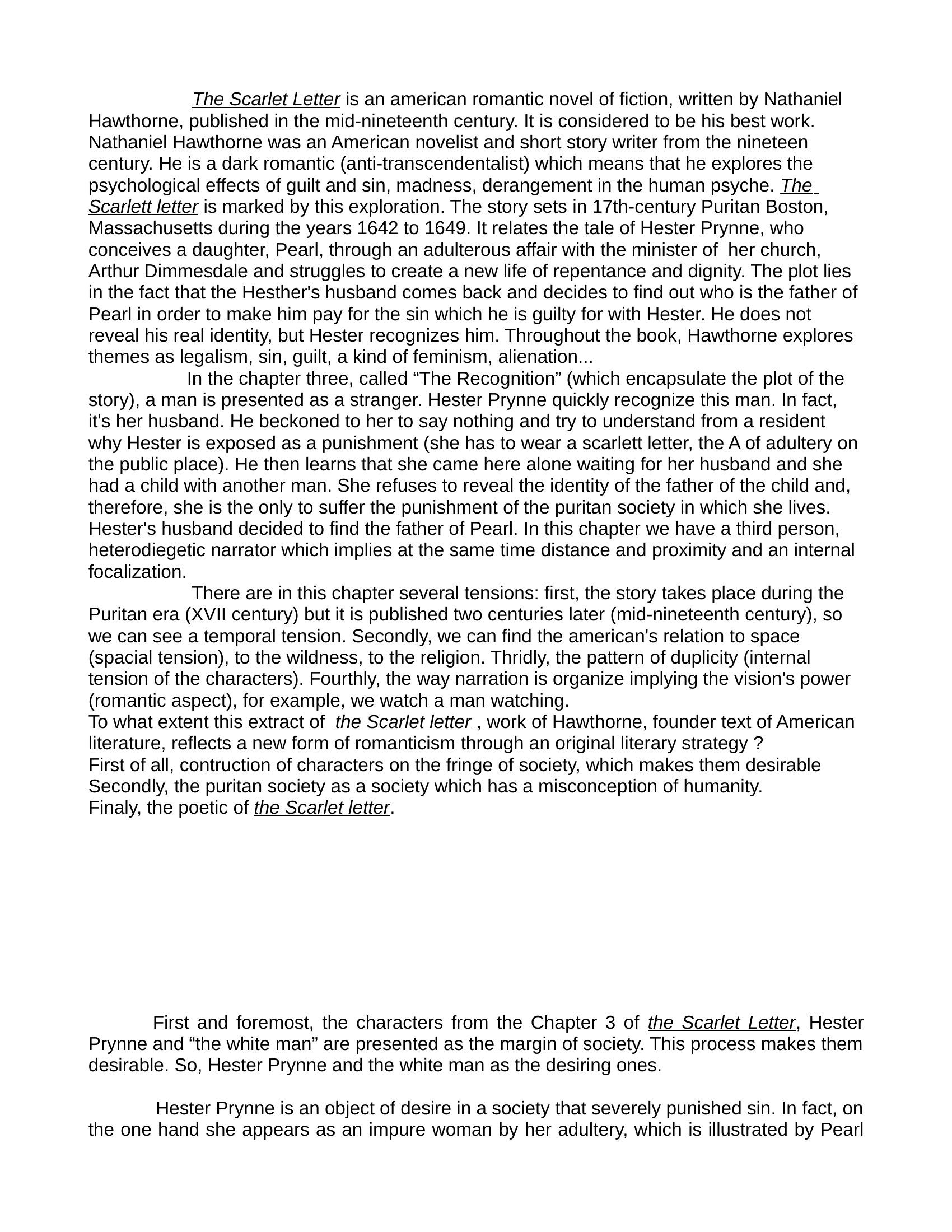The Scarlett letter
Publié le 14/05/2014

Extrait du document
«
The Scarlet Letter is an american romantic novel of fiction, written by Nathaniel
Hawthorne, published in the mid-nineteenth century.
It is considered to be his best work.
Nathaniel Hawthorne was an American novelist and short story writer from the nineteen
century.
He is a dark romantic (anti-transcendentalist) which means that he explores the
psychological effects of guilt and sin, madness, derangement in the human psyche.
The
Scarlett letter is marked by this exploration.
The story sets in 17th-century Puritan Boston,
Massachusetts during the years 1642 to 1649.
It relates the tale of Hester Prynne, who
conceives a daughter, Pearl, through an adulterous affair with the minister of her church,
Arthur Dimmesdale and struggles to create a new life of repentance and dignity.
The plot lies
in the fact that the Hesther's husband comes back and decides to find out who is the father of
Pearl in order to make him pay for the sin which he is guilty for with Hester.
He does not
reveal his real identity, but Hester recognizes him.
Throughout the book, Hawthorne explores
themes as legalism, sin, guilt, a kind of feminism, alienation...
In the chapter three, called “The Recognition” (which encapsulate the plot of the
story), a man is presented as a stranger.
Hester Prynne quickly recognize this man.
In fact,
it's her husband.
He beckoned to her to say nothing and try to understand from a resident
why Hester is exposed as a punishment (she has to wear a scarlett letter, the A of adultery on
the public place).
He then learns that she came here alone waiting for her husband and she
had a child with another man.
She refuses to reveal the identity of the father of the child and,
therefore, she is the only to suffer the punishment of the puritan society in which she lives.
Hester's husband decided to find the father of Pearl.
In this chapter we have a third person,
heterodiegetic narrator which implies at the same time distance and proximity and an internal
focalization.
There are in this chapter several tensions: first, the story takes place during the
Puritan era (XVII century) but it is published two centuries later (mid-nineteenth century), so
we can see a temporal tension.
Secondly, we can find the american's relation to space
(spacial tension), to the wildness, to the religion.
Thridly, the pattern of duplicity (internal
tension of the characters).
Fourthly, the way narration is organize implying the vision's power
(romantic aspect), for example, we watch a man watching.
To what extent this extract of the Scarlet letter , work of Hawthorne, founder text of American
literature, reflects a new form of romanticism through an original literary strategy ?
First of all, contruction of characters on the fringe of society, which makes them desirable
Secondly, the puritan society as a society which has a misconception of humanity.
Finaly, the poetic of the Scarlet letter .
First and foremost, the characters from the Chapter 3 of the Scarlet Letter , Hester
Prynne and “the white man” are presented as the margin of society.
This process makes them
desirable.
So, Hester Prynne and the white man as the desiring ones.
Hester Prynne is an object of desire in a society that severely punished sin.
In fact, on
the one hand she appears as an impure woman by her adultery, which is illustrated by Pearl.
»
↓↓↓ APERÇU DU DOCUMENT ↓↓↓
Liens utiles
- From The Scarlet Letter - anthology.
- Pi. Pi, Greek letter (p) used in mathematics as the symbol
- the scarlet letter chap 21
- Nathaniel Hawthorne The Scarlet Letter Essay
- FICHE DE LECTURE: « Originality in the Byzantine Letter: The Case of exile », M. Mullett

































